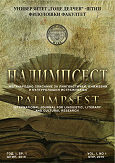THE ROLE AND FUNCTION OF DISCOURSE MARKERS: EXAMPLES FROM A YOUTUBE INTERVIEW
Abstract
This study examines the importance and role of discourse markers in an online YouTube interview. It specifically focuses on discourse markers, or so-called pragmatic markers, in spoken language. Discourse markers (DM) are widely used in oral communication and are often found in dialogues between speakers and their interlocutors. Speakers use them to ensure a smooth flow of conversation and to help their interlocutors understand the meaning of their utterances appropriately. The use of DM in this interview depends on the context and objectives. The choice of DM and other language elements depends on the target audience of the interview. Additionally, speakers use discourse markers to adjust the intensity of their statements or mitigate the linguistic content of their actions. The analysis sheds light on the relationship between the participants in the respective communication and demonstrates how speakers adjust politeness based on their conversation partner and situation. Examination of the language use of the moderator and the guest in the interview confirms the assumption that language is related to the attitudes of the speakers and that language is adapted depending on the communicative situation.
Keywords: discourse markers; intensifiers; repetitions; interview.
Downloads
References
[2] Auer, P. (1998): Zwischen Parataxe und Hypotaxe: ‘abhängige Hauptsätze’ im Gesprochenen und Geschriebenen Deutsch. In: Zeitschrift für germanistische Linguistik 26, 284-307.
[3] Auer, P. & Günthner, S. (2005): Die Entstehung von Diskursmarkern im Deutschen – ein Fall von Grammatikalisierung? In: Leuschner, Torsten / Mortelmans, Tanja / De Groodt, Sarah (Hg.), Grammatikalisierung im Deutschen. Berlin: de Gruyter, 335-362.
[4]Auer, P. & Maschler, Y. (eds.) (2016): NU/NÅ. A family of discourse markers across the languages of Europe and beyond. Berlin: de Gruyter.
[5] Bayerl, P. S. (2004): Disambiguierung deutschsprachiger Diskursmarker: Eine Pilot-Studie. In: Linguistik online 18, 3-17.
[6] Blakemore, D. (2002): Relevance and Linguistic Meaning. The semantics and pragmatics of discourse markers. Cambridge: Cambridge University Press.
[7] Blakemore, D. (2004): Discourse markers. In: Horn, Laurence R. / Ward, Gregory (eds.), The Handbook of Pragmatics. Malden: Blackwell, 221-240.
[8] Foolen, Ad. (2011): Pragmatic markers in a sociopragmatic perspective. In: Andersen, Gisle / Aijmer, Karin (eds.), Pragmatics of Society. Handbook of Pragmatics 5. Berlin: de Gruyter Mouton, 217-242.
[9] Gohl, Ch. & Günthner, S. (1999): Grammatikalisierung von weil als Diskursmarker in der gesprochenen Sprache. In: Zeitschrift für Sprachwissenschaft 18, 39-75.
[10] Günthner, S. (1999): Entwickelt sich der Konzessivkonnektor obwohl zum Diskursmarker? Grammatikalisierungstendenzen im gesprochenen Deutsch. In: Linguistische Berichte 180, 409-446.
[11] Hartung, N. (2012): Und-Koordination in der frühen Kindersprache. Eine korpusbasierte Untersuchung. Dissertation, Eberhard-Karls-Universität Tübingen. Online unter: https://publikationen.unituebingen.de/xmlui/handle/10900/46995 [abgerufen am 06.02.2023].
[12] Heine, B. (2013): On discourse markers: Grammaticalization, pragmaticalization, or something else? In: Linguistics 51, 1205-1247.
[13] Imo, W. (2007): Zur Anwendung der Construction Grammar auf die gesprochene Sprache – der Fall ‘ich mein(e)’. In: Ágel, Vilmos / Hennig, Mathilde (Hg.). In: Zugänge zur Grammatik der gesprochenen Sprache. Tübingen: Niemeyer, 3-34.
[14] Imo, W. (2012): Wortart Diskursmarker? In: Rothstein, Björn (Hg.), Nichtflektierende Wortarten. Berlin: de Gruyter, 48-88.
[15] Konerding, K-P. (2004): Semantische Variation, Diskurspragmatik, historische Entwicklung und Grammatikalisierung. Das Phänomenspektrum der Partikel also. In: Pohl, Inge & Konerding, KlausPeter (Hg.), Stabilität und Flexibilität in der Semantik. Frankfurt/Main: Lang, 199-237. 75
[16] Lange, I. (1999): Die sequenzielle Struktur von Anrufbeantworter Kommunikation. Magisterarbeit, Universität Hamburg. Online unter: https://kops.uni-konstanz.de/handle/123456789/3698 [abgerufen am 06.02.2023].
[17] Maschler, Y. & Schiffrin, D. (2015): Discourse markers. Language, meaning, and context. In: Tannen, Deborah / Hamilton, Heidi E. / Schiffrin, Deborah (eds.), The Handbook of Discourse Analysis. 2nd ed. Chichester: Wiley, 189- 221.
[18] Mroczynski, R. (2012): Grammatikalisierung und Pragmatikalisierung. Zur Herausbildung der Diskursmarker wobei, weil und ja im gesprochenen Deutsch. Tübingen: Narr.
[19] Rehbock, H. (2009): “... ohne jetzt nun gleich aggressiv zu werden”: Ein Zeitadverb als Diskursmarker. In: Zeitschrift für germanistische Linguistik 37, 236-265.
[20] Tissot, F. (2015): Gemeinsamkeit schaffen in der Interaktion: Diskursmarker und Lautelemente in zürichdeutschen Erzählsequenzen. Frankfurt/Main: Lang.
[21] Umbach, C. & Stede, M. (1999): Kohärenzrelationen: Ein Vergleich von Kontrast und Konzession. Berlin: Technische Universität. KIT-Report 148. Online unter: https://www.researchgate.net/publication/241112385_Koharenzrelationen_ Ein_Vergleich_von_Kontrast_und_Konzession [abgerufen am 06.02.2023].





